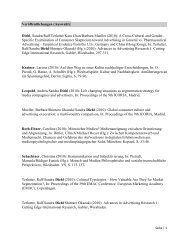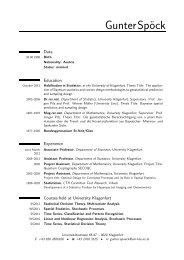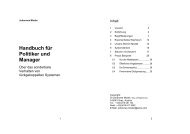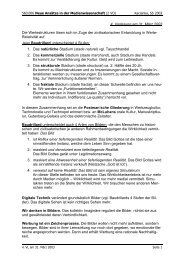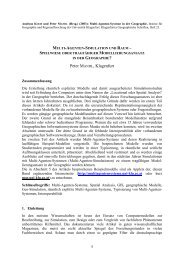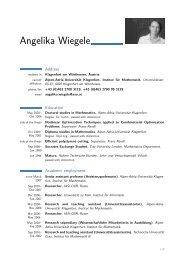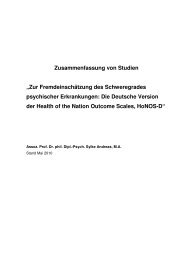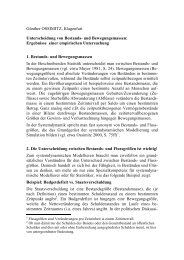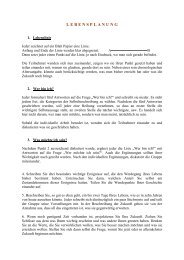Musical Pitch in Nonsense Syllables: Correlations with the Vowel ...
Musical Pitch in Nonsense Syllables: Correlations with the Vowel ...
Musical Pitch in Nonsense Syllables: Correlations with the Vowel ...
You also want an ePaper? Increase the reach of your titles
YUMPU automatically turns print PDFs into web optimized ePapers that Google loves.
<strong>Musical</strong> <strong>Pitch</strong> <strong>in</strong> <strong>Nonsense</strong> <strong>Syllables</strong>: <strong>Correlations</strong> <strong>with</strong> <strong>the</strong> <strong>Vowel</strong> System and<br />
Evolutionary Perspectives<br />
Gertraud Fenk-Oczlon, *1 August Fenk #2<br />
* Department of L<strong>in</strong>guistics and Computational L<strong>in</strong>guistics, University of Klagenfurt, Austria<br />
# Department of Media and Communication Studies, University of Klagenfurt, Austria<br />
1<br />
gertraud.fenk@uni-klu.ac.at, 2 august.fenk@uni-klu.ac.at<br />
ABSTRACT<br />
In a first step we present correspondences between <strong>the</strong><br />
<strong>in</strong>ventories of vowel systems and musical scales across cultures.<br />
These correspondences concern an upper limit of roughly 12<br />
elements, a lower limit of 2-3 elements and <strong>the</strong> 5-vowel systems<br />
and pentatonic scales as <strong>the</strong> most frequent patterns. S<strong>in</strong>ce vowels<br />
play a decisive role <strong>in</strong> generat<strong>in</strong>g <strong>the</strong> sound or <strong>the</strong> sonority of<br />
syllables that <strong>in</strong> turn are basic units of both speech and s<strong>in</strong>g<strong>in</strong>g,<br />
<strong>the</strong>se parallels are considered as a possible l<strong>in</strong>k between language<br />
and music. Fur<strong>the</strong>rmore we found correspondences between<br />
vowel pitch and musical pitch <strong>in</strong> Alp<strong>in</strong>e yodellers whose text<br />
entirely consisted of nonsense syllables: A succession of <strong>the</strong><br />
vowels [i] and [o] <strong>in</strong> mean<strong>in</strong>gless syllables was most often<br />
accompanied by a succession of high and low pitch <strong>in</strong> melody. In<br />
o<strong>the</strong>r Austrian folksongs conta<strong>in</strong><strong>in</strong>g only several passages of<br />
nonsense syllables, <strong>the</strong> present study shows a similar correlation,<br />
i.e. a co<strong>in</strong>cidence of <strong>the</strong> vowel [i] <strong>with</strong> <strong>the</strong> highest pitch <strong>in</strong><br />
melody. These co<strong>in</strong>cidences between <strong>the</strong> vowel system and<br />
musical <strong>in</strong>tervals shall be discussed <strong>in</strong> regard of a possible<br />
evolution of music and speech out of a half-musical precursor.<br />
I. INTRODUCTION<br />
S<strong>in</strong>g<strong>in</strong>g is assumed to be <strong>the</strong> most orig<strong>in</strong>al form of music,<br />
maybe even older than drumm<strong>in</strong>g and than s<strong>in</strong>g<strong>in</strong>g<br />
accompanied by rhythm <strong>in</strong>struments. And s<strong>in</strong>g<strong>in</strong>g, alone or<br />
accompanied by <strong>in</strong>struments, still is <strong>the</strong> most widespread form<br />
of music. The terms “s<strong>in</strong>g<strong>in</strong>g” or “vocal music” not only apply<br />
to songs hav<strong>in</strong>g mean<strong>in</strong>gful texts. Accord<strong>in</strong>g to Nettl (1954, p.<br />
192) <strong>the</strong>y also apply to songs “which have only mean<strong>in</strong>gless<br />
syllables.” He reports that <strong>in</strong> many songs of <strong>the</strong> Arapahos and<br />
o<strong>the</strong>r American Indians senseless syllables are common as<br />
complete or partial song texts. On <strong>the</strong> next page of this article he<br />
already states that “<strong>the</strong>re is a tendency for high tones to be sung<br />
on syllables <strong>with</strong> front vowels /…/ while lower tones are more<br />
apt to be sung on back vowels /…/ This may have a<br />
physiological basis, s<strong>in</strong>ce we know it is easier to s<strong>in</strong>g high tones<br />
<strong>with</strong> front vowels and low tones <strong>with</strong> back vowels”.<br />
The idea of a close evolutionary relationship between<br />
language and music traces back as far as Charles Darw<strong>in</strong> who<br />
decidedly argued for music as a precursor of articulate speech:<br />
“We must suppose that <strong>the</strong> rhythm and cadences of oratory are<br />
derived from previously developed musical powers.” (Darw<strong>in</strong>,<br />
1871, p.12). Jespersen, however, considered two different<br />
possibilities: Language as a descendent of music (Jespersen,<br />
1922), as already <strong>in</strong> Darw<strong>in</strong>, and both language and music as<br />
descendents of “half-musical unanalysed expressions.”<br />
(Jespersen, 1895). This idea of a common and less specified<br />
precursor of language and music seems to get a revival (cf.<br />
Brown, 2000, Mi<strong>the</strong>n, 2005, Fitch, 2009). In a recent study we<br />
refer, moreover, to Morley’s (2003, p. 149) description of a<br />
“progressively, <strong>in</strong>creas<strong>in</strong>gly complex proto-language based on<br />
tone-dom<strong>in</strong>ated affective social utterances” and take Nettl’s<br />
(2000, p. 469) description of archaic s<strong>in</strong>g<strong>in</strong>g as a model for<br />
language evolution:<br />
“Simple musical phrases repeated, modified, and repeated<br />
aga<strong>in</strong>, are an appropriate production system as well as an ideal<br />
carrier current system for transmitt<strong>in</strong>g symbols, i.e., elements of<br />
a cod<strong>in</strong>g system associated <strong>with</strong> particular mean<strong>in</strong>gs by virtue<br />
of <strong>the</strong>ir rule-based use.” (Fenk-Oczlon & Fenk, forthcom<strong>in</strong>g, p.<br />
172).<br />
There are of course physical cues that make us perceive a<br />
certa<strong>in</strong> phrase as ra<strong>the</strong>r musical (sung) or l<strong>in</strong>guistic (spoken),<br />
but <strong>in</strong>terest<strong>in</strong>gly <strong>the</strong> very same “spoken phrase can be made to<br />
be heard conv<strong>in</strong>c<strong>in</strong>gly as sung /…/ simply by repeat<strong>in</strong>g <strong>the</strong><br />
phrase several times over.” (Deutsch, 2008, p. 8). This f<strong>in</strong>d<strong>in</strong>g<br />
gives rise to several tentative assumptions: Start<strong>in</strong>g from our<br />
archaic s<strong>in</strong>g<strong>in</strong>g-model one might speculate that <strong>the</strong> redundancy<br />
of a repetitive melodic Gestalt foregrounds m<strong>in</strong>or but<br />
significant changes of <strong>the</strong> articulatory Gestalt. Maybe <strong>the</strong><br />
long-term differentiation of s<strong>in</strong>g<strong>in</strong>g and speech was<br />
accompanied by a long-term differentiation of specialized<br />
attention mechanisms that may overrule each o<strong>the</strong>r or switch<br />
depend<strong>in</strong>g on slightly differ<strong>in</strong>g cues, comparable to perceptual<br />
effects described <strong>in</strong> Gestalt psychology. If so, <strong>the</strong><br />
speech-relevant mechanism is <strong>the</strong> one specialized on an utmost<br />
efficient extraction and analysis of referential mean<strong>in</strong>g also<br />
from less redundant, non-repetitive utterances. The melodic or<br />
prosodic features are used <strong>in</strong> that process, but recede from focal<br />
attention - until <strong>the</strong> phrase is repeated for several times.<br />
Our own studies concern parallels between music and<br />
language that may contribute to <strong>the</strong> contemporary debate about<br />
<strong>the</strong> evolutionary pathways of <strong>the</strong>se achievements <strong>in</strong> at least two<br />
respects:<br />
(a) Parallels <strong>in</strong> <strong>the</strong> length of musical and l<strong>in</strong>guistic phrases:<br />
Articulatory mechanisms, as well as <strong>the</strong> cognitive/perceptual<br />
mechanisms <strong>in</strong>volved <strong>in</strong> <strong>the</strong> programm<strong>in</strong>g and on-l<strong>in</strong>e control<br />
of <strong>in</strong>tonation units, are effective <strong>in</strong> both speech and s<strong>in</strong>g<strong>in</strong>g.<br />
Even more generally: Phrases <strong>in</strong> language (clauses) can be<br />
viewed as a special case of action units (Fenk-Oczlon & Fenk,<br />
2002) reflect<strong>in</strong>g <strong>the</strong>ir general pattern: a restricted number of<br />
elements <strong>with</strong><strong>in</strong> a unit of 1.5 to 3 seconds and a negative<br />
correlation between <strong>the</strong> number and <strong>the</strong> duration of <strong>the</strong><br />
elements. This argument may of course be extended to phrases<br />
<strong>in</strong> vocal music, <strong>in</strong> vocal music accompanied by <strong>in</strong>strumental<br />
music, and <strong>in</strong> purely <strong>in</strong>strumental music. Some relevant data: In<br />
a sample of 34 languages <strong>the</strong> mean number of syllables per<br />
clause was <strong>in</strong> <strong>the</strong> range around Miller’s (1956) magical number<br />
7, from 5 <strong>in</strong> Dutch to 10 <strong>in</strong> Japanese (Fenk-Oczlon & Fenk,<br />
1999), and 75 % of <strong>the</strong> phrases <strong>in</strong> <strong>the</strong> Essen Folksong<br />
Collection (Huron, 1996) and <strong>the</strong> Ottmann Collection
(Temperley, 2001) conta<strong>in</strong> from 6 to 10 notes. A duration of 2-3<br />
sec is not only a characteristics of our musical and l<strong>in</strong>guistic<br />
phrases, but is, <strong>in</strong>terest<strong>in</strong>gly, also reported (Sugiura &<br />
Masataka, 1995) for <strong>the</strong> coos of Japanese macaques. Thus,<br />
many parallels between language and music can be expla<strong>in</strong>ed<br />
by perceptual and cognitive mechanisms <strong>in</strong>volved <strong>in</strong> both<br />
speech and music.<br />
(b) The second parallel concerns vowels and musical<br />
<strong>in</strong>tervals. This will be <strong>the</strong> topic of <strong>the</strong> follow<strong>in</strong>g chapters.<br />
II. CORRESPONDENCES BETWEEN<br />
VOWEL SYSTEMS AND MUSICAL<br />
SCALES<br />
S<strong>in</strong>ce vowels play a decisive role <strong>in</strong> generat<strong>in</strong>g <strong>the</strong> sound or<br />
<strong>the</strong> sonority of syllables we assumed (Fenk-Oczlon & Fenk,<br />
2005) and <strong>in</strong>deed found (Fenk-Oczlon & Fenk, forthcom<strong>in</strong>g)<br />
some parallels between <strong>the</strong> <strong>in</strong>ventories of vowel systems and<br />
musical scales across cultures. Most languages have 5-vowel<br />
systems and all studies available for us claim that <strong>the</strong> pentatonic<br />
(5-tone) scale is more widely used than any o<strong>the</strong>r formation.<br />
The second most common <strong>in</strong>ventories are, depend<strong>in</strong>g on <strong>the</strong><br />
source, ei<strong>the</strong>r <strong>the</strong> 7-vowel systems and heptatonic scales or <strong>the</strong><br />
6-vowel system and <strong>the</strong> hexatonic scales. As to <strong>the</strong> upper limits<br />
of <strong>the</strong> respective <strong>in</strong>ventories <strong>the</strong> maximum is around 12.<br />
Accord<strong>in</strong>g to Burns, “<strong>the</strong> present 12-<strong>in</strong>terval Western scale is<br />
probably a practical limit. Any division of <strong>the</strong> octave <strong>in</strong>to<br />
<strong>in</strong>tervals smaller than quarter tones is perceptually irrelevant for<br />
melodic <strong>in</strong>formation.” (Burns, 1999: 257). And <strong>in</strong> language, <strong>the</strong><br />
12 vowel-systems aga<strong>in</strong> mark a maximum <strong>in</strong> Cro<strong>the</strong>rs’ (1978)<br />
sample. Concern<strong>in</strong>g <strong>the</strong> m<strong>in</strong>imum size of vowel or tone<br />
<strong>in</strong>ventories, <strong>the</strong> data vary between 2 or 3 units (Table 1).<br />
It might be promis<strong>in</strong>g to look whe<strong>the</strong>r languages <strong>with</strong> a<br />
lower number of vowels also tend to have smaller scale sizes.<br />
This seems to be a difficult task because of <strong>the</strong> lack of a<br />
database of scale size across musical cultures. But <strong>the</strong>re are<br />
some <strong>in</strong>dications <strong>in</strong> support of this hypo<strong>the</strong>sis:<br />
The pentatonic scale is a generally, and especially <strong>in</strong> <strong>the</strong><br />
eastern Asian music, widespread pattern, and <strong>the</strong> respective<br />
eastern Asian languages tend to have 5-vowel systems. Only<br />
recently we found relevant data on Arapaho language and music<br />
perfectly fitt<strong>in</strong>g this hypo<strong>the</strong>sis: Accord<strong>in</strong>g to “The Arapaho<br />
Project” of <strong>the</strong> University of Colorado and <strong>the</strong><br />
“Encyclopedia-Arapaho music”, Arapaho has 4 vowels and 3<br />
basic diphthongs and scales of 4 to 6 tones. There are, <strong>in</strong><br />
addition, some relevant data concern<strong>in</strong>g Australian Aborig<strong>in</strong>al<br />
music and language which seem to support our hypo<strong>the</strong>sis: It is<br />
generally difficult <strong>in</strong> <strong>the</strong> songs of Australian Aborig<strong>in</strong>als to<br />
assign pitches to conventional scales; Sachs (1965) describes<br />
<strong>the</strong>ir melodies as ”tumbl<strong>in</strong>g stra<strong>in</strong>s“ or fall<strong>in</strong>g melodies.<br />
Never<strong>the</strong>less we see some correspondences between <strong>the</strong><br />
descriptions of <strong>the</strong>ir vowel systems and musical <strong>in</strong>tervals: Most<br />
of <strong>the</strong> Aborig<strong>in</strong>al languages have three vowels, only those from<br />
<strong>the</strong> Nor<strong>the</strong>rn Territory have five (Butcher & Anderson, 2008).<br />
And Lauridsen (1983) reports exactly from those cultures <strong>in</strong> <strong>the</strong><br />
Nor<strong>the</strong>rn Territory <strong>the</strong> use of a higher number of pitches.<br />
Table 1. Some cross-cultural co<strong>in</strong>cidences between <strong>the</strong> size of<br />
vowel-systems and musical scales.<br />
<strong>Vowel</strong> systems<br />
• Most languages have 5<br />
vowels (Cro<strong>the</strong>rs 1978);<br />
different authors claim<br />
ei<strong>the</strong>r 6 or 7 vowels as <strong>the</strong><br />
next most frequent<br />
<strong>in</strong>ventory<br />
• A m<strong>in</strong>imum of 2-3 and a<br />
maximum of 12 vowels<br />
accord<strong>in</strong>g to Cro<strong>the</strong>rs<br />
(1978)<br />
<strong>Musical</strong> scales<br />
• Pentatonic (5-tone) scales<br />
are used more widely than<br />
any o<strong>the</strong>r formation. It is,<br />
depend<strong>in</strong>g on <strong>the</strong> source,<br />
ei<strong>the</strong>r followed by <strong>the</strong><br />
hexatonic (6-tone) scales or<br />
by <strong>the</strong> heptatonic (7-tone)<br />
scales<br />
• 2-3 tones seem to mark a<br />
lower limit (Nettl 2000) and<br />
<strong>the</strong> 12-tones of <strong>the</strong><br />
chromatic scale an upper<br />
limit<br />
III. CORRESPONDENCES BETWEEN<br />
VOWEL PITCH AND MELODIC<br />
DIRECTION IN NONSENSE SYLLABLES<br />
It has been known s<strong>in</strong>ce Meyer (1896) that, o<strong>the</strong>r th<strong>in</strong>gs<br />
be<strong>in</strong>g equal, vowels have <strong>in</strong>tr<strong>in</strong>sic pitch. High vowels such as [i]<br />
or [u] have a higher fundamental frequency (F 0 ) than low<br />
vowels such as [a] or [æ]. Concern<strong>in</strong>g <strong>the</strong> formants we know<br />
that front vowels such as [i] or [y] have a low first formant (F1)<br />
and a high second formant (F2) whereas back vowels such as [o]<br />
or [u] have a high F1 and a low F2.<br />
An <strong>in</strong>terest<strong>in</strong>g f<strong>in</strong>d<strong>in</strong>g relat<strong>in</strong>g melodic to vowel pitch is<br />
reported <strong>in</strong> Hughes (2000). He found that <strong>in</strong> shoga, <strong>the</strong><br />
Japanese mnemonic/iconic system for represent<strong>in</strong>g melodies,<br />
<strong>the</strong> vowels are correlated to melodic direction accord<strong>in</strong>g to <strong>the</strong>ir<br />
F2 order<strong>in</strong>g. For <strong>in</strong>stance: a succession of <strong>the</strong> vowels [i],<br />
show<strong>in</strong>g <strong>the</strong> highest frequency <strong>in</strong> F2, and [o] <strong>with</strong> a low F2 was<br />
most often accompanied by a succession of high and low pitch<br />
<strong>in</strong> melody.<br />
A. <strong>Vowel</strong> pitch <strong>in</strong> nonsense syllables of Alp<strong>in</strong>e yodellers<br />
Hav<strong>in</strong>g <strong>in</strong> m<strong>in</strong>d <strong>the</strong> sound and vowel patterns of some Alp<strong>in</strong>e<br />
yodellers and <strong>the</strong> freedom of yodellers <strong>in</strong> comb<strong>in</strong><strong>in</strong>g senseless<br />
syllables <strong>with</strong> successions of notes, we assumed that this type of<br />
music is composed accord<strong>in</strong>g to <strong>the</strong> pattern found <strong>in</strong> <strong>the</strong> shoga<br />
system.<br />
In search for such a correlation we studied (Fenk-Oczlon &<br />
Fenk, forthcom<strong>in</strong>g) all of <strong>the</strong> monophonic yodellers (n = 15) <strong>in</strong><br />
Pommer’s collection from 1893. The whole text of <strong>the</strong>se<br />
yodellers is a succession of nonsense syllables (Figure 1).<br />
The results make <strong>in</strong>ferential statistics unnecessary: In 118<br />
out of 121 cases of a syllable conta<strong>in</strong><strong>in</strong>g an [i] preced<strong>in</strong>g a<br />
syllable conta<strong>in</strong><strong>in</strong>g an [o] <strong>the</strong> melody descended; <strong>in</strong> one case <strong>the</strong><br />
melody raised, <strong>in</strong> two cases <strong>the</strong> pitches stayed at <strong>the</strong> same. And<br />
<strong>in</strong> <strong>the</strong> 133 <strong>in</strong>stances of an [o]→[i] succession <strong>the</strong> melody<br />
ascended <strong>with</strong> only one exception (equal pitch). Instances of an<br />
[i] followed or preceded by o<strong>the</strong>r vowels were less frequent but<br />
offered <strong>the</strong> same picture: one exception <strong>in</strong> 44 cases of an [i]→[a]<br />
succession, and no exceptions <strong>in</strong> 10 cases of [a]→[i] and <strong>in</strong> 6<br />
cases of [u]→[i].
Figure 1. An example of an Alp<strong>in</strong>e yodeller (from Pommer’s<br />
collection, 1893, p. 9) show<strong>in</strong>g descend<strong>in</strong>g melody <strong>in</strong> [i]→[o,a]<br />
successions and ascend<strong>in</strong>g melody <strong>in</strong> [o,a]→[i] successions.<br />
B. <strong>Vowel</strong> pitch <strong>in</strong> nonsense syllables of o<strong>the</strong>r Austrian<br />
folksongs<br />
Can this pattern, or at least a related pattern that allows a<br />
simple and fast evaluation, be generalized to o<strong>the</strong>r songs<br />
conta<strong>in</strong><strong>in</strong>g only passages <strong>with</strong> nonsense syllables The first<br />
example belongs to <strong>the</strong> so-called “Gstanzln”<br />
(Austrian-Bavarian mock<strong>in</strong>g songs): “Da ob’n auf’m Bergal…<br />
ho la di ri di jo, ho la di jo, ho la di ri di jo, ho la di jo…”. The<br />
second one is a very old German folksong: “E<strong>in</strong> Vogel wollte<br />
Hochzeit halten….fi di ra la la , fi di ra la la, fi di ra la la la<br />
la…”<br />
We assumed that <strong>in</strong> <strong>the</strong> nonsense passages of such songs <strong>the</strong><br />
highest pitch would co<strong>in</strong>cide <strong>with</strong> an [i]. In order to test this<br />
assumption we <strong>in</strong>vestigated all songs <strong>in</strong> Dawidowicz’s (1980)<br />
collection that are assigned to <strong>the</strong> category Austrian folksong<br />
and <strong>in</strong>clude passages <strong>with</strong> nonsense syllables (Figure 2).<br />
The results: Almost all songs (24 of 26) showed, <strong>in</strong> <strong>the</strong>ir<br />
passages conta<strong>in</strong><strong>in</strong>g exclusively nonsense syllable, <strong>with</strong>out any<br />
exception <strong>the</strong> expected co<strong>in</strong>cidence of <strong>the</strong> vowel [i] <strong>with</strong> <strong>the</strong><br />
highest pitch <strong>in</strong> melody. Interest<strong>in</strong>gly, most of <strong>the</strong> songs<br />
conta<strong>in</strong><strong>in</strong>g passages <strong>with</strong> nonsense syllables can be localized <strong>in</strong><br />
<strong>the</strong> Alp<strong>in</strong>e regions of Austria.<br />
Figure 2. Two examples of folksongs (from Dawidowicz’s<br />
collection, 1980, p. 94, 182) <strong>with</strong> passages of nonsense syllables:<br />
<strong>the</strong> vowel [i] <strong>in</strong> nonsense syllables co<strong>in</strong>cides <strong>with</strong> <strong>the</strong> highest pitch<br />
<strong>in</strong> melody.<br />
IV. CONCLUSION<br />
If it is <strong>the</strong> aim to f<strong>in</strong>d a parsimonious explanation for <strong>the</strong><br />
parallels reported between language and music, one may, first<br />
of all, address <strong>the</strong> mediat<strong>in</strong>g role of s<strong>in</strong>g<strong>in</strong>g. If one assumes that<br />
vocal music shaped <strong>the</strong> most often only accompany<strong>in</strong>g<br />
<strong>in</strong>strumental music, one may view a more or less archaic form<br />
of s<strong>in</strong>g<strong>in</strong>g as a l<strong>in</strong>k between speech and music <strong>in</strong> a broader sense,<br />
i.e., <strong>in</strong> all its varieties. But <strong>the</strong> respective f<strong>in</strong>d<strong>in</strong>gs also seem to<br />
have some impact on <strong>the</strong> evolutionary models mentioned <strong>in</strong> our<br />
<strong>in</strong>troduction.<br />
S<strong>in</strong>g<strong>in</strong>g <strong>with</strong>out words – as <strong>in</strong> <strong>the</strong> songs of animals, <strong>in</strong><br />
“animal-like songs”, <strong>in</strong> many utterances of our <strong>in</strong>fants, <strong>in</strong><br />
yodell<strong>in</strong>g, <strong>in</strong> certa<strong>in</strong> Arapaho songs (Nettl, 1956) – is<br />
cognitively less demand<strong>in</strong>g than <strong>the</strong> use of a more or less<br />
arbitrary code. And it will well function <strong>with</strong>out and before<br />
gett<strong>in</strong>g familiar <strong>with</strong> such a code. This reduces <strong>the</strong> plausibility<br />
of language as a precursor of music. For a closer <strong>in</strong>spection<br />
rema<strong>in</strong> those two possibilities already favored <strong>in</strong> Jespersen<br />
(1895): Music ei<strong>the</strong>r as “protolanguage” or both language and<br />
music as descendents of “half-musical” utterances.<br />
But <strong>with</strong> respect to tonal modulation s<strong>in</strong>g<strong>in</strong>g is more<br />
demand<strong>in</strong>g than speech. For this and some o<strong>the</strong>r reasons it is<br />
more plausible that s<strong>in</strong>g<strong>in</strong>g “prepared” <strong>the</strong> vocal tract for<br />
speech than <strong>the</strong> o<strong>the</strong>r way round.<br />
A model account<strong>in</strong>g for <strong>the</strong>se considerations, thus assum<strong>in</strong>g<br />
a less specialized precursor <strong>with</strong> a more s<strong>in</strong>gsong- like tonality,<br />
not only allows for <strong>the</strong> correspondences between language and<br />
music <strong>in</strong> <strong>the</strong> repertoires, <strong>in</strong> phrase length and rhythmic structure<br />
of phrases. It also sheds some light on <strong>the</strong> key role of <strong>the</strong> vowel<br />
system and accentuates its role <strong>in</strong> language evolution. <strong>Vowel</strong>s<br />
carry, as already mentioned, most of <strong>the</strong> syllables’ sound or<br />
sonority <strong>in</strong> both s<strong>in</strong>g<strong>in</strong>g and speech. Dur<strong>in</strong>g <strong>the</strong> evolution of<br />
speech that became <strong>the</strong> specialist for referential mean<strong>in</strong>g<br />
(Brown, 2000), <strong>the</strong> sound of <strong>the</strong> less specialized<br />
tone-dom<strong>in</strong>ated precursor dim<strong>in</strong>ished. This, and <strong>the</strong> fact that<br />
<strong>the</strong> formant structure of <strong>the</strong> vowels rema<strong>in</strong>s <strong>the</strong> same whe<strong>the</strong>r<br />
<strong>the</strong> respective syllables are spoken or sung gives rise to some<br />
ra<strong>the</strong>r speculative assumptions:<br />
(a) Maybe it is more than a mere co<strong>in</strong>cidence that those high<br />
front vowels [i] or [e] that are easier to be sung <strong>in</strong> high tones (cf.<br />
Nettl, 1954), play a special role <strong>in</strong> phenomena of sound<br />
symbolism or phonosemantics, for <strong>in</strong>stance, <strong>in</strong> <strong>the</strong> more or less
universal tendency to be used <strong>in</strong> names for <strong>the</strong> sound or noise<br />
produced by <strong>the</strong> smaller exemplars of a category, and thus()<br />
also <strong>in</strong> <strong>the</strong> names for smaller exemplars of objects and <strong>in</strong><br />
dim<strong>in</strong>utive expressions. But a well-founded <strong>the</strong>ory also requires<br />
fur<strong>the</strong>r studies on commonalities regard<strong>in</strong>g <strong>the</strong> sound structure,<br />
e.g. by <strong>in</strong>tegrat<strong>in</strong>g phenomena of sound symbolism and<br />
utterances of whistled languages which are <strong>in</strong>telligible for <strong>the</strong><br />
reason (Meyer 2007) that <strong>the</strong>y simulate acoustic cues carry<strong>in</strong>g<br />
<strong>the</strong> melody of speech.<br />
(b) The second speculation: Our considerations amount to<br />
<strong>the</strong> idea that <strong>the</strong> evolution of language was characterized by a<br />
gradual reduction of <strong>the</strong> tonal character of <strong>the</strong> common<br />
precursor of language and music. This is <strong>in</strong> l<strong>in</strong>e <strong>with</strong> and<br />
supports <strong>the</strong> conclusions of e.g. Morley (2003) and Masataka<br />
(2009, p.11). Accord<strong>in</strong>g to Masataka <strong>the</strong> prel<strong>in</strong>guistic system<br />
was nei<strong>the</strong>r identical <strong>with</strong> modern language nor <strong>with</strong> modern<br />
music, but “resembled music more closely than language.”<br />
To end up <strong>with</strong> a prospect of future research:<br />
Aga<strong>in</strong> speculative, but <strong>in</strong> pr<strong>in</strong>ciple accessible for direct<br />
empirical test<strong>in</strong>g is <strong>the</strong> question <strong>in</strong>dicated <strong>in</strong> Section II whe<strong>the</strong>r<br />
cultures <strong>with</strong> a higher number of vowels also tend to use a<br />
higher number of pitches <strong>in</strong> musical melody.<br />
REFERENCES<br />
Brown, S. (2000). The “musilanguage” model of human evolution. In<br />
N.L. Wall<strong>in</strong>, B. Merker & S. Brown (eds), The orig<strong>in</strong>s of music<br />
(pp.271-300). Cambridge, MA: The MIT Press.<br />
Burns E. M. (1999). Intervals, scales, and tun<strong>in</strong>g. In D. Deutsch (ed),<br />
The psychology of music (pp. 215-264). 2nd ed. San Diego:<br />
Academic Press.<br />
Butcher, A., & Anderson, V. (2008). The vowels of Australian<br />
Aborig<strong>in</strong>al English. Proceed<strong>in</strong>gs of Interspeech, Bristol,<br />
Australia.<br />
Cro<strong>the</strong>rs, J. (1978). Typology and universals of vowel systems. In J. H.<br />
Greenberg (Ed.), Universals of human language (pp. 93-152).<br />
Stanford: Stanford University Press.<br />
Darw<strong>in</strong>, Ch. (1871). The descent of man and selection <strong>in</strong> relation to<br />
sex. Retrieved August 24, 2004, from<br />
http://www.darw<strong>in</strong>-literature.com/ The_Descent_Of_Man/21.html.<br />
Dawidowicz, A. (1980) Österreichisches Liederbuch. Komm, s<strong>in</strong>g mit!<br />
Innsbruck/Neu Rum: Musikverlag Helbl<strong>in</strong>g.<br />
Deutsch, D. (2008). The ICMPC Series, and some current research on<br />
music perception and cognition. In K. Miyazaki, Y. Hiraga, M.<br />
Adachi, Y. Nakajima, & M. Tsuzaki (Eds.), Proceed<strong>in</strong>gs of <strong>the</strong><br />
10 th International Conference on Music Perception and<br />
Cognition (ICMPC10)(pp.6-9).<br />
Encyclopedia – Arapaho music (2009). Retrieved March 3, 2009,<br />
from<br />
http:/www.experiencefestival.com/a/Arapaho_music/id/1916800<br />
Fenk-Oczlon, G., & Fenk, A. (1999). Cognition, quantitative<br />
l<strong>in</strong>guistics, and systemic typology. L<strong>in</strong>guistic Typology, 3-2,<br />
151-177.<br />
Fenk-Oczlon, G., & Fenk, A. (2002). The clausal structure of<br />
l<strong>in</strong>guistic and pre-l<strong>in</strong>guistic behavior. In T. Givón and B.F.<br />
Malle (Eds.), The evolution of language out of pre-language<br />
(pp.215-229). Amsterdam: John Benjam<strong>in</strong>s.<br />
Fenk-Oczlon, G., & Fenk, A. (2005). Cognitive constra<strong>in</strong>ts on <strong>the</strong><br />
organization of language and music. In B.G. Bara, L. Barsalou &<br />
M. Bucciarelli (eds), Proceed<strong>in</strong>gs of <strong>the</strong> Twenty-Seventh Annual<br />
Conference of <strong>the</strong> Cognitive Science Society (p. 2476). Mahwah,<br />
NJ: Erlbaum.<br />
Fenk-Oczlon, G., & Fenk, A. (forthcom<strong>in</strong>g). Some parallels between<br />
language and music from a cognitive and evolutionary<br />
perspective. Musicae Scientias, special issue “Music and<br />
Evolution, 201-226.<br />
Fitch, W. Tecumseh (2009). <strong>Musical</strong> protolanguage: Darw<strong>in</strong>’s <strong>the</strong>ory<br />
of language evolution revisited. Retrieved April 23, 2009, from<br />
http://www.st-andrews.ac.uk/~wtsf/Darw<strong>in</strong>LanguageEvolution.html<br />
Hughes D.W. (2000). No nonsense: <strong>the</strong> logic and power of<br />
acoustic-iconic mnemonic systems. British Journal of<br />
Ethnomusicology, 9/ii, 95-122.<br />
Huron, D. (1996). The melodic arch <strong>in</strong> Western folksongs, Comput<strong>in</strong>g<br />
<strong>in</strong> Musicology, 10, 3-23.<br />
Jespersen, O. (1983 [1895]). Progress <strong>in</strong> language. Amsterdam<br />
Classics <strong>in</strong> L<strong>in</strong>guistics 17. Amsterdam: John Benjam<strong>in</strong>s.<br />
Jespersen, O. (1922). Language. London: Allen.<br />
Lauridsen, J. (1983). <strong>Musical</strong> scales <strong>in</strong> Australian aborig<strong>in</strong>al songs:<br />
Structure and social implications. Doctoral dissertation,<br />
University of Maryland.<br />
Masataka, N. (2009). The orig<strong>in</strong>s of language and <strong>the</strong> evolution of<br />
music: a comparative perspective. Physics of Life Reviews,<br />
6,11-22.<br />
Meyer, E. A. (1896). Zur Tonbewegung des Vokals im gesprochenen<br />
und gesungenen E<strong>in</strong>zelwort. Phonetische Studien, 10, 1-21.<br />
Meyer, J. (2007). What does <strong>the</strong> typology of whistled forms of<br />
language teach us about prosody In Book of Abstracts (p. 173),<br />
7 th International Conference of <strong>the</strong> Association for L<strong>in</strong>guistic<br />
Typology, Paris, September 25-28.<br />
Miller, G. (1956). The magical number seven, plus or m<strong>in</strong>us two:<br />
some limits on our capacity for process<strong>in</strong>g <strong>in</strong>formation:<br />
Psychological Review, 63, 81-97.<br />
Mi<strong>the</strong>n, S. (2005). The s<strong>in</strong>g<strong>in</strong>g Neanderthals.The Orig<strong>in</strong>s of Music,<br />
language, M<strong>in</strong>d, and Body. London:Weidenfeld & Nicolson.<br />
Morley, I. (2003). The evolutionary orig<strong>in</strong>s and archaeology of music.<br />
Doctoral Dissertation, University of Cambridge,<br />
Nettl, B. (1954). Text-music relationships <strong>in</strong> Arapaho songs.<br />
Southwestern Journal of Anthropology, 10, 192-199.<br />
Nettl, B. (1956). Music <strong>in</strong> Primitive Culture. Cambridge: Harvard<br />
University Press.<br />
Nettl, B. (2000). An ethnomusicologist contemplates universals <strong>in</strong><br />
musical sound and musical culture. In N.L. Wall<strong>in</strong>, B. Merker<br />
and S. Brown (Eds.), The orig<strong>in</strong>s of music (pp.463 - 72).<br />
Cambridge, MA: The MIT Press.<br />
Pommer, J. (1893). 252 Jodler und Juchezer. Wien: Rebay &<br />
Robitschek.<br />
Sachs, C. (1965). The wellspr<strong>in</strong>gs of music. New:York;<br />
MCGraw-Hill.<br />
Sugiura, H., & Masataka, N. (1995). Temporal and acoustic flexibility<br />
<strong>in</strong> vocal exchanges of coo calls <strong>in</strong> Japanese macaques (Macaca<br />
fuscata). In E. Zimmermann, J. D.Newman & U. Jurgen (pp.<br />
121-140). New York: Plenum.<br />
The Arapaho Project (2009). Retrieved March 3, 2009, from<br />
www.colorado.edu/csilw/arapahoproject/language/pronunciation.htm<br />
Temperley, D. (2001). The cognition of basic musical structures.<br />
Cambridge/Mass, London: MIT Press.



